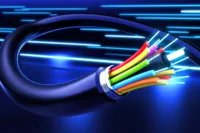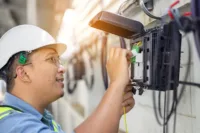
In the scenic city of Flagstaff, Arizona, where the winter landscape is often blanketed in snow, maintaining robust infrastructure is crucial—for keeping the roads clear and ensuring reliable telecommunications. Properly installing fiber optic and voice/data cabling is vital to withstand the challenges posed by cold and snowy weather.
Challenges of Snow and Cold Weather
Flagstaff’s frequent and heavy snowfalls present unique challenges for telecommunications infrastructure. Snow and ice can cause physical damage to exposed cables, while temperature fluctuations and frozen ground can lead to shifts that may stretch or snap buried cables. Also, maintaining and repairing these installations becomes more complex and hazardous in winter.
Advantages of Fiber Optics and Voice/Data Cabling in Cold Climates
Fiber optic cables, which transmit data through light signals along glass or plastic fibers, offer several benefits over traditional metal-based communication lines, such as copper. These include less susceptibility to temperature variations and higher bandwidth for faster, more reliable internet service. Similarly, modern voice/data cabling solutions are designed to simultaneously handle multiple voice, data, and video communications, providing comprehensive connectivity solutions that are crucial during the long winter months.
Ensuring Proper Installation
Proper fiber optic and voice/data cabling installation is essential to maximize their effectiveness in snowy regions. Key considerations include:
- Depth of Installation: Cables should be buried deep enough to avoid disruption from ground frost and the mechanical pressure of frozen soil, based on local soil conditions and frost line data.
- Physical Protection: Where cables are routed above ground, such robust conduct is necessary to protect against environmental hazards like falling icicles and heavy snow.
- Routing Considerations: Planning the cable route to avoid areas prone to snow accumulation, frequent plowing, or ice movement can reduce the risk of cable exposure and damage.
- Quality Materials: Using high-quality, weather-resistant materials for both fiber optic and voice/data cables, as well as their protective sheathing, can prevent moisture ingress and physical damage from environmental exposure.
- Regular Maintenance: Regular inspections and maintenance become even more critical in winter, ensuring fiber optic and voice/data cabling systems remain operational after severe weather events.
Impact on Flagstaff Residents
For the residents of Flagstaff, well-installed fiber optic and voice/ data cabling systems mean improved reliability and speed of internet connections and enhanced communication capabilities. This connectivity is vital for emergency services, economic activities, education, and healthcare—particularly during winter when travel can be risky or impossible.
The growth of Flagstaff and its increasing digital dependency underscore the importance of resilient telecommunications infrastructure. Properly installed and maintained fiber optic and voice/data cabling systems are not merely about ensuring connectivity; they are crucial for keeping the community engaged and safe during challenging winter conditions, making them indispensable assets in snowy regions.











